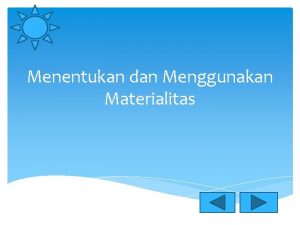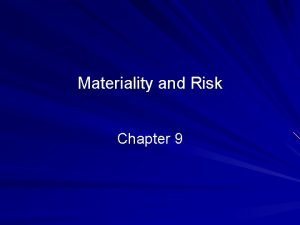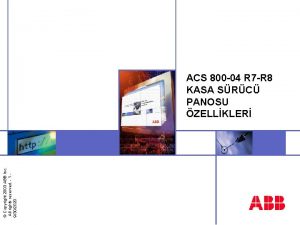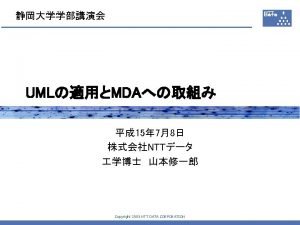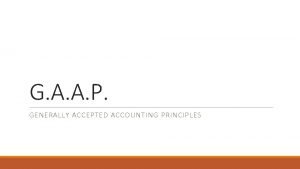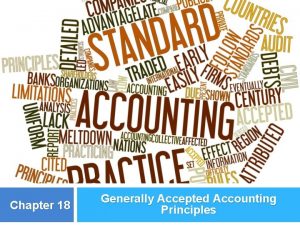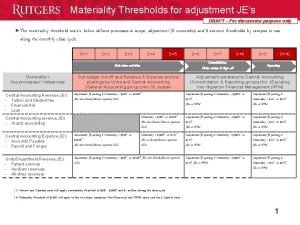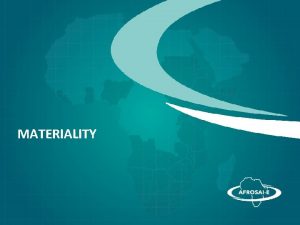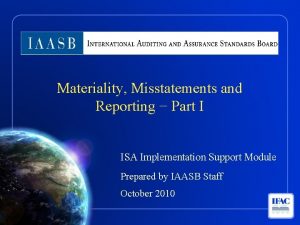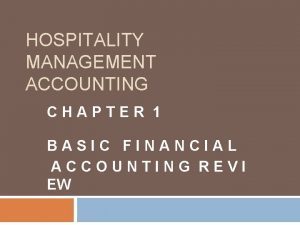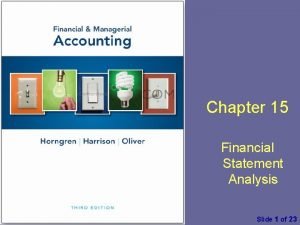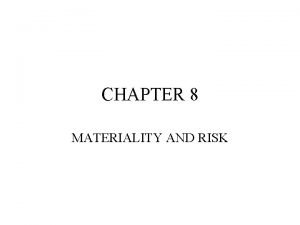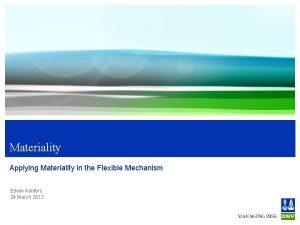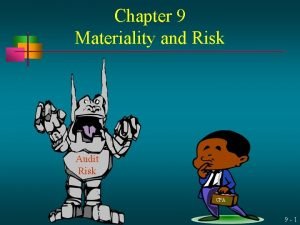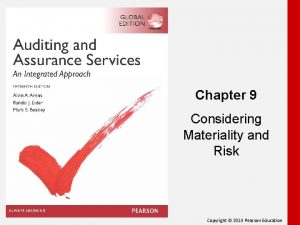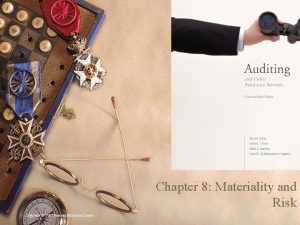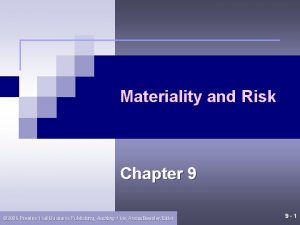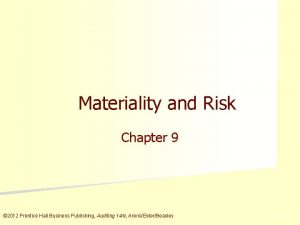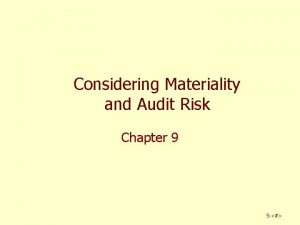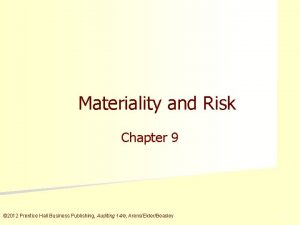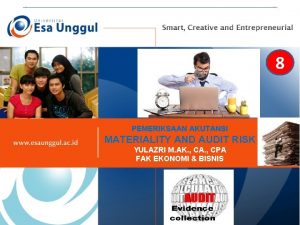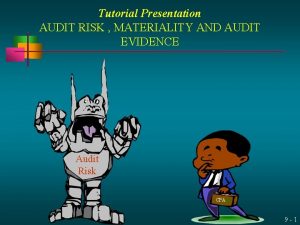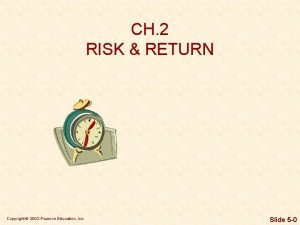CHAPTER 8 Materiality and Risk Copyright 2003 Pearson








































































- Slides: 72

CHAPTER 8 Materiality and Risk Copyright 2003 Pearson Education Canada Inc. 8 -1

Steps in audit planning preplan obtain background informat ion obtain information about client’s legal obligations perform preliminary analytical procedures set materiality, and assess acceptable audit risk and inherent risk Copyright 2003 Pearson Education Canada Inc. 8 -2

The phrase “reasonable assurance” in the audit report indicates that there is some audit risk. Scope paragraph: We conducted our audit in accordance with generally accepted auditing standards. Those standards require that we plan and perform the audit to obtain reasonable assurance about whether the financial statements are free of material misstatement. . . Copyright 2003 Pearson Education Canada Inc. 8 -3

Note the reference to materiality in the audit report. Scope paragraph: We conducted our audit in accordance with generally accepted auditing standards. Those standards require that we plan and perform the audit to obtain reasonable assurance about whether the financial statements are free of material misstatement. . . Copyright 2003 Pearson Education Canada Inc. 8 -4

Note the reference to materiality in the audit report. What is materiality? Copyright 2003 Pearson Education Canada Inc. 8 -5

What is materiality? Materiality is the magnitude of omitted or misstated information that, in the light of surrounding circumstances, would change or influence the decision of someone relying on the financial statements who has a reasonable knowledge of business and economic activities. Copyright 2003 Pearson Education Canada Inc. 8 -6

For each engagement, auditors typically establish a preliminary judgment about materiality. ? Copyright 2003 Pearson Education Canada Inc. 8 -7

For each engagement, auditors typically establish a preliminary judgment about materiality. The preliminary judgment about materiality is the maximum amount by which the auditor believes the statements could be misstated and still not affect the decisions of reasonable users. Copyright 2003 Pearson Education Canada Inc. 8 -8

For each engagement, auditors typically establish a preliminary judgment about materiality. - may be based on a firm-wide formula considering net income, gross profit, total assets, revenue, shareholders’ equity, e. g. , 5% of net income adjusted according to auditor judgment Copyright 2003 Pearson Education Canada Inc. 8 -9

How does the preliminary judgment about materiality affect the volume of audit evidence? Copyright 2003 Pearson Education Canada Inc. 8 - 10

How does the preliminary judgment about materiality affect the volume of audit evidence? A small materiality estimate will result in more evidence. “Investigate misstatements over $100. ” Copyright 2003 Pearson Education Canada Inc. 8 - 11

How does the preliminary judgment about materiality affect the volume of audit evidence? A small materiality estimate will result in more evidence. “Investigate misstatements over $100. ” A large materiality estimate will result in less evidence. “Investigate misstatements over $10, 000. ” Copyright 2003 Pearson Education Canada Inc. 8 - 12

Factors affecting the preliminary judgment about materiality - materiality is strongly influenced by $1, 000. . . client size peanuts $1, 000 - WOW! Copyright 2003 Pearson Education Canada Inc. 8 - 13

Factors affecting the preliminary judgment about materiality - materiality is strongly influenced by client size - multiple bases of materiality may be appropriate FOR EXAMPLE: The auditor may be concerned that: net income is not misstated by $100, 000, and total assets is not misstated by $300, 000. Copyright 2003 Pearson Education Canada Inc. 8 - 14

Factors affecting the preliminary judgment about materiality - materiality is strongly influenced by client size - multiple bases of materiality may be appropriate - a fraud, illegal act or other irregularity is considered more ma terial than an error of the same dollar amount. WHY? Copyright 2003 Pearson Education Canada Inc. 8 - 15

Factors affecting the preliminary judgment about materiality - materiality is strongly influenced by client size - multiple bases of materiality may be appropriate - a fraud, illegal act or other rregularity is considered more material than an error of the same dollar amount. - small differences from contractual requirements may be material (e. g. , ratios related to debt agreements) Copyright 2003 Pearson Education Canada Inc. 8 - 16

Factors affecting the preliminary judgment about materiality - multiple bases of materiality may be appropriate - a fraud, illegal act or other irregularity is considered more material than an error of the same dollar amount. - small differences from contractual requirements may be material (e. g. , ratios related to debt agreements) - immaterial amounts may accumulate into a material amount Copyright 2003 Pearson Education Canada Inc. 8 - 17

Steps in audit planning preplan obtain background information What is acceptable audit risk? obtain information about client’s legal obligations perform preliminary analytical procedures set materiality, and assess acceptable audit risk and inherent risk Copyright 2003 Pearson Education Canada Inc. 8 - 18

What is acceptable audit risk? set materiality, and assess acceptable audit risk and inherent risk Acceptable audit risk is the risk that the auditor is willing to accept that an unqualified opinion will be issued for statements that are materially misstated. Copyright 2003 Pearson Education Canada Inc. 8 - 19

the lower the acceptable audit risk 2% Copyright 2003 Pearson Education Canada Inc. 8 - 20

the lower the acceptable audit risk 2% 98% the greater the certainty the auditor wants to achieve Copyright 2003 Pearson Education Canada Inc. 8 - 21

the lower the 98% acceptable audit the greater risk 2% the certainty the auditor wants to achieve the greater the amount of audit evidence and costs Copyright 2003 Pearson Education Canada Inc. 8 - 22

What is achieved audit risk? Copyright 2003 Pearson Education Canada Inc. 8 - 23

What is achieved audit risk? Achieved audit risk is the actual risk that the statements are materially misstated after an unqualified opinion has been issued. Copyright 2003 Pearson Education Canada Inc. 8 - 24

How do acceptable and achieved audit risk affect the audit report? Copyright 2003 Pearson Education Canada Inc. 8 - 25

How do acceptable and achieved audit risk affect the audit report? if achieved audit risk 5% < acceptable audit risk 10% audit report is supported by the evidence Copyright 2003 Pearson Education Canada Inc. 8 - 26

How do acceptable and achieved audit risk affect the audit report? if achieved audit risk 15% > acceptable audit risk 5% audit report is not supported by the evidence Copyright 2003 Pearson Education Canada Inc. 8 - 27

Risk is very difficult to quantify. subjective based on judgment Copyright 2003 Pearson Education Canada Inc. 8 - 28

How can an auditor reduce audit risk? Copyright 2003 Pearson Education Canada Inc. 8 - 29

How can an auditor reduce achieved audit risk? audit risk achieved risk gather more evidence sufficient, appropriate acceptable risk evidence and cost Copyright 2003 Pearson Education Canada Inc. 8 - 30

Auditors may face additional audit risk because of business risk; i. e. , the risk of loss or injury to the auditor’s practice because of a client relationship (e. g. , litigation, adverse publicity, etc. ). Copyright 2003 Pearson Education Canada Inc. 8 - 31

Auditors may face additional audit risk because of business risk; i. e. , the risk of loss or injury to the auditor’s practice because of a client relationship (e. g. , litigation, adverse publicity, etc. ). Auditors should consider: - degree to which users rely on the client’s financial statements Financial Statements Ace Company Copyright 2003 Pearson Education Canada Inc. 8 - 32

Auditors may face additional audit risk because of business risk; i. e. , the risk of loss or injury to the auditor’s practice because of a client relationship (e. g. , litigation, adverse publicity, etc. ). Auditors should consider: - degree to which users rely on the client’s financial statements - likelihood that the client will have financial difficulties after the report has been issued Copyright 2003 Pearson Education Canada Inc. 8 - 33

Auditors may face additional audit risk because of business risk; i. e. , the risk of loss or injury to the auditor’s practice because of a client relationship (e. g. , litigation, adverse publicity, etc. ). Auditors should consider: - degree to which users rely on the client’s financial statements - likelihood that the client will have financial difficulties after the report has been issued - management integrity Copyright 2003 Pearson Education Canada Inc. 8 - 34

Audit Risk has 3 components which combine to make the audit risk model: audit inherent = x risk control detection x risk Copyright 2003 Pearson Education Canada Inc. 8 - 35

Audit Risk has 3 components which combine to make the audit risk model: inherent audit = x risk control detection x risk ? Copyright 2003 Pearson Education Canada Inc. 8 - 36

Inherent Risk - defined as the risk that material misstatements exist before considering the client’s internal controls Copyright 2003 Pearson Education Canada Inc. 8 - 37

Inherent Risk - defined as the risk that material misstatements exist before considering the client’s internal controls - some accounts, components, cycles are inherently riskier than others Copyright 2003 Pearson Education Canada Inc. 8 - 38

Inherent Risk - defined as the risk that material misstatements exist before considering the client’s internal controls - some accounts, components, cycles are inherently riskier than others auditors must: - identify inherently risky areas - gather appropriate evidence regarding those areas Copyright 2003 Pearson Education Canada Inc. 8 - 39

Inherent risk considerations - nature of client’s business EXAMPLE: Sally’s Clothing Boutique rents store space in a house. What are the inherently risky accounts? Sally’s Copyright 2003 Pearson Education Canada Inc. 8 - 40

Inherent risk considerations - nature of client’s business EXAMPLE: Sally’s Clothing Boutique rents store space in a house. What are the inherently risky accounts? cash inventory accounts payable Sally’s Copyright 2003 Pearson Education Canada Inc. 8 - 41

Inherent risk considerations - nature of client’s business EXAMPLE: Sally’s Clothing Boutique rents store space in a house. What are the inherently less risky accounts? Sally’s Copyright 2003 Pearson Education Canada Inc. 8 - 42

Inherent risk considerations - nature of client’s business EXAMPLE: Sally’s Clothing Boutique rents store space in a house. What are the inherently less risky accounts? capital assets equity Sally’s Copyright 2003 Pearson Education Canada Inc. 8 - 43

Inherent risk considerations - nature of client’s business - integrity of management poor integrity more evidence Copyright 2003 Pearson Education Canada Inc. 8 - 44

Inherent risk considerations - nature of client’s business - integrity of management - client motivation to misstate the financial statements Are management bonuses based on net income? Copyright 2003 Pearson Education Canada Inc. 8 - 45

Inherent risk considerations - nature of client’s business - integrity of management - client motivation to misstate the financial statements - results of previous audits - accounts, components which had material misstatements in prior years should be tested extensively in the current year Copyright 2003 Pearson Education Canada Inc. 8 - 46

Inherent risk considerations - nature of client’s business - integrity of management - client motivation to misstate the financial statements - results of previous audits - initial vs. repeat engagements Why are initial audit engagements inherently riskier than repeats? Copyright 2003 Pearson Education Canada Inc. 8 - 47

Why are initial audit engagements inherently riskier than repeats? - during the initial engagement, the auditor is not familiar with client systems, internal controls, and personnel Copyright 2003 Pearson Education Canada Inc. 8 - 48

Why are initial audit engagements inherently riskier than repeats? - during the initial engagement, the auditor is not familiar with client systems, internal controls, and personnel - during the initial engagement, beginning balances must be extensively examined Copyright 2003 Pearson Education Canada Inc. 8 - 49

Inherent risk considerations - nature of client’s business - integrity of management - client motivation to misstate the financial statements - results of previous audits - initial vs. repeat engagements - related parties Copyright 2003 Pearson Education Canada Inc. 8 - 50

Inherent risk considerations - nature of client’s business - integrity of management - client motivation to misstate the financial statements - results of previous audits - initial vs. repeat engagements Has - related parties GAAP been - non-routine transactions correctly applied? Copyright 2003 Pearson Education Canada Inc. 8 - 51

Inherent risk considerations - related parties - nonroutine transactions - judgment required to correctly record transactions What do you mean by “obsolete” inventory? Copyright 2003 Pearson Education Canada Inc. 8 - 52

Inherent risk considerations - related parties - nonroutine transactions - judgment required to correctly record transactions - susceptibility to defalcation Example: CASH Copyright 2003 Pearson Education Canada Inc. 8 - 53

Inherent risk considerations - judgment required to correctly record transactions - susceptibility to defalcation - makeup of the population Which is riskier? average of a/p, 15 days average of a/p, 45 days Copyright 2003 Pearson Education Canada Inc. 8 - 54

Audit Risk has 3 components which combine to make the audit risk model: inherent audit = x risk control detection x risk ? Copyright 2003 Pearson Education Canada Inc. 8 - 55

Audit Risk has 3 components which combine to make the audit risk model: audit inherent = x risk control detection x risk the risk that material misstatements will not be prevented or detected by internal controls Copyright 2003 Pearson Education Canada Inc. 8 - 56

Audit Risk has 3 components which combine to make the audit risk model: inherent audit = x risk control detection x risk ? Copyright 2003 Pearson Education Canada Inc. 8 - 57

Audit Risk has 3 components which combine to make the audit risk model: audit inherent = x risk control detection x risk Detection risk is the risk that material misstatements will not be detected by the auditor. Copyright 2003 Pearson Education Canada Inc. 8 - 58

Why does detection risk exist? Copyright 2003 Pearson Education Canada Inc. 8 - 59

Why does detection risk exist? - the auditor samples (sampling risk) $ $ $ $$ $ $ $ Copyright 2003 Pearson Education Canada Inc. 8 - 60

Why does detection risk exist? - the auditor samples (sampling risk) - the auditor may select ineffective audit procedures Copyright 2003 Pearson Education Canada Inc. 8 - 61

Why does detection risk exist? - the auditor samples (sampling risk) - the auditor may select ineffective audit procedures - the auditor may apply procedures ineffectively Copyright 2003 Pearson Education Canada Inc. 8 - 62

Why does detection risk exist? - the auditor samples (sampling risk) - the auditor may select ineffective audit procedures - the auditor may apply procedures ineffectively - the auditor may incorrectly evaluate the results of procedures Copyright 2003 Pearson Education Canada Inc. 8 - 63

Why does detection risk exist? - the auditor samples (sampling risk) - the auditor may select ineffective audit procedures - the auditor may apply procedures ineffectively - the auditor may incorrectly evaluate the results of procedures The last 3 reasons are nonsampling errors. The risk of their occurrence is non-sampling risk. Copyright 2003 Pearson Education Canada Inc. 8 - 64

Audit Risk has 3 components which combine to make the audit risk model: inherent audit = x risk control detection x risk Which of these components can the auditor influence? Copyright 2003 Pearson Education Canada Inc. 8 - 65

Audit Risk has 3 components which combine to make the audit risk model: audit inherent control = x x risk Which of these components can the auditor influence? indirectly: influence management detection risk directly - larger sample size - enhanced training Copyright 2003 Pearson Education Canada Inc. 8 - 66

Audit risk as a double-hoop basketball game internal controls auditing procedures Copyright 2003 Pearson Education Canada Inc. 8 - 67

Audit risk as a double-hoop basketball game internal controls misstatements (inherently risky accounts auditing are better shots) procedures Copyright 2003 Pearson Education Canada Inc. 8 - 68

Audit risk as a double-hoop basketball game internal controls misstatements detected by internal controls auditing procedures Copyright 2003 Pearson Education Canada Inc. 8 - 69

Audit risk as a double-hoop basketball game internal controls misstatements not detected by internal controls (control risk) auditing procedures Copyright 2003 Pearson Education Canada Inc. 8 - 70

Audit risk as a double-hoop basketball game internal controls misstatements detected by auditors auditing procedures Copyright 2003 Pearson Education Canada Inc. 8 - 71

Audit risk as a double-hoop basketball game internal controls misstatements undetected by auditors (detection risk) auditing procedures Copyright 2003 Pearson Education Canada Inc. 8 - 72
 Perbedaan overall materiality dan performance materiality
Perbedaan overall materiality dan performance materiality Copyright 2003 pearson education inc
Copyright 2003 pearson education inc Materiality and risk
Materiality and risk Liquidity measures
Liquidity measures Copyright 2003
Copyright 2003 Copyrightfrance
Copyrightfrance Copyright 2003
Copyright 2003 2017 pearson education inc
2017 pearson education inc 2017 pearson education inc
2017 pearson education inc Copyright 2010 pearson education inc
Copyright 2010 pearson education inc Copyright 2009 pearson education inc
Copyright 2009 pearson education inc 2018 pearson education inc
2018 pearson education inc 2014 pearson education inc
2014 pearson education inc Copyright 2010 pearson education inc
Copyright 2010 pearson education inc Copyright 2010 pearson education inc
Copyright 2010 pearson education inc Copyright by pearson education inc. answers
Copyright by pearson education inc. answers Copyright 2005 pearson prentice hall inc
Copyright 2005 pearson prentice hall inc Copyright 2009 pearson education inc
Copyright 2009 pearson education inc Copyright pearson education inc
Copyright pearson education inc Copyright 2010 pearson education inc
Copyright 2010 pearson education inc Copyright 2010 pearson education inc
Copyright 2010 pearson education inc Copyright 2010 pearson education inc
Copyright 2010 pearson education inc 2010 pearson education inc
2010 pearson education inc Copyright 2010 pearson education inc
Copyright 2010 pearson education inc Composition copyright example
Composition copyright example Copyright 2010 pearson education inc
Copyright 2010 pearson education inc Copyright 2009 pearson education inc
Copyright 2009 pearson education inc Copyright 2009 pearson education inc
Copyright 2009 pearson education inc 2009 pearson education inc
2009 pearson education inc Copyright 2009 pearson education inc
Copyright 2009 pearson education inc Copyright pearson education inc
Copyright pearson education inc Prentice hall publishing
Prentice hall publishing 2011 pearson education inc
2011 pearson education inc Educational pearson pearson times
Educational pearson pearson times Educational pearson pearson times
Educational pearson pearson times Pearson education inc publishing as pearson prentice hall
Pearson education inc publishing as pearson prentice hall Pearson education inc. 2012
Pearson education inc. 2012 Pearson education inc publishing as pearson prentice hall
Pearson education inc publishing as pearson prentice hall Materiality principal
Materiality principal Weighted average inventory costing method
Weighted average inventory costing method Materiality concept
Materiality concept Conservatism accounting principle
Conservatism accounting principle Which item is a constraint in financial accounting?
Which item is a constraint in financial accounting? Materiality threshold
Materiality threshold Calculate overall materiality
Calculate overall materiality Isa materiality
Isa materiality Hotel accounting basics
Hotel accounting basics Accounting constraints
Accounting constraints Residual risk and secondary risk pmp
Residual risk and secondary risk pmp Business risk vs financial risk capital structure
Business risk vs financial risk capital structure Attributable risk formula
Attributable risk formula Population attributable risk
Population attributable risk Draw rmmm plan
Draw rmmm plan Risk mitigation avoidance
Risk mitigation avoidance How to calculate relative risk
How to calculate relative risk Tracing vs vouching
Tracing vs vouching Absolute risk vs relative risk
Absolute risk vs relative risk Activity sheet 1 how diversified are these portfolios
Activity sheet 1 how diversified are these portfolios Risk classification system
Risk classification system Pembelanjaan resiko
Pembelanjaan resiko The biggest risk is not taking any risks
The biggest risk is not taking any risks Key risk indicators financial risk management
Key risk indicators financial risk management Ar = ir x cr x dr
Ar = ir x cr x dr Risk map risk management
Risk map risk management Bae yong-kyun
Bae yong-kyun Promotion planning process
Promotion planning process Ewles and simnett planning model 2003
Ewles and simnett planning model 2003 Ewles and simnett planning model
Ewles and simnett planning model Hopper and traugott 2003
Hopper and traugott 2003 Chapter 12 stoichiometry answer key pearson
Chapter 12 stoichiometry answer key pearson Pearson chapter 6
Pearson chapter 6 Return on common stockholders equity formula
Return on common stockholders equity formula Fiancial analysis chapter 15 pearson solutions
Fiancial analysis chapter 15 pearson solutions
